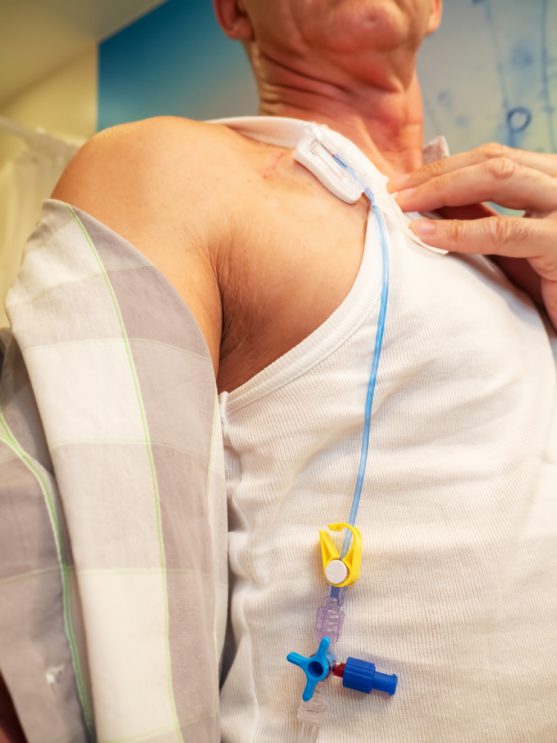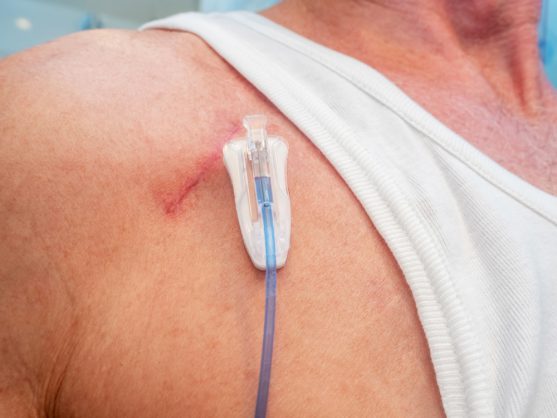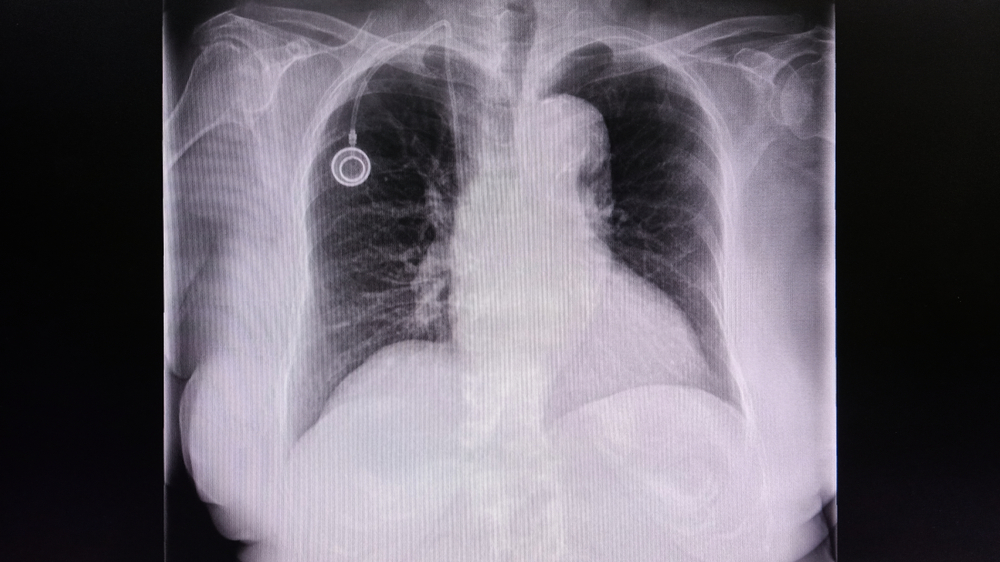If you are going to have a port inserted, you might have a few questions about what the procedure will be like and whether it will impact your everyday life. Here we answer the most commonly asked questions about chemoports.
Q1. What is a chemoport?
A Chemoport is a small medical appliance that is implanted beneath the skin. A catheter connects the port to a vein. Under the skin, the port has a septum through which drugs can be injected and blood samples can be drawn many times, usually with less discomfort for the patient.

A device consists of a reservoir compartment (the portal) that has a silicone bubble for needle insertion (the septum), with an attached plastic tube (the catheter). The device is surgically inserted under the skin in the upper chest or in the arm and appears as a swelling under the skin.
The catheter runs from the portal from underneath the skin and is surgically inserted into a vein (usually the jugular vein in the neck or subclavian veins). Ideally, the tip of the catheter terminates in the superior vena cava, just upstream of the right atrium. This position allows infused agents to be spread throughout the body quickly and efficiently.
Q2. How is the chemoport inserted?
The port is implanted usually by a surgical procedure that requires placing two small incisions – one in the upper chest measuring about 2cm and the other in the neck about 5mm. A pocket is created in the upper chest where the port is placed and anchored to the underlying muscle.
The catheter is then tunnelled into the neck and inserted into the vein. The surgeon may use ultrasound guidance for puncturing the vein to insert the catheter.
The incisions are closed with sutures or glue. The procedure may be performed under local anesthesia with some sedation or under a formal general anesthesia where you will be put to sleep. A C-arm may be used during the procedure to confirm the position of the tip of the catheter.

Q3. What should we expect on the day of insertion?
On the day of the surgery you will be required to avoid consuming food or drink for about six hours prior. The surgery is usually performed in the operation theatre under strict aseptic precautions under local or general anesthesia. You may be started on a regular oral diet after a few hours after the procedure once you recover from sedation.
You should expect some bruising, swelling, and tenderness to the area of your body where the port is placed. These symptoms usually go away gradually over the next 5 to 7 days. Painkillers and antibiotics may be advised for relief of the discomfort and to prevent infections.
A dressing is applied at the incision site that is usually left in place for 24 to 48hrs. Your surgeon may perform a chest X-ray to confirm the position of the tip of the catheter.

Q4. What are the risks involved?
The procedure is usually a smooth process. This procedure may be associated with following risks:
- Infection: Placement of a foreign body is associated with a mild risk of infection. Your doctor will usually take precautions by placing it under aseptic precautions, under antibiotic cover. An infected implant will require to be removed to prevent septic complications.
- Thrombosis: Formation of a blood clot in the catheter may block the device irrevocably. To prevent clotting the Chemoport is flushed with saline and heparin, usually by a nurse or other medical professional, or a properly trained family member or the patient, at least once every four weeks, or more often in conjunction with administering medication.
- Age: If the device is put into a child, the child’s growth means that the catheter becomes relatively shorter and will move away from the inferior part of the superior vena cava. It might be necessary to remove or replace it.
- Pneumothorax: Attempts to gain access to the subclavian vein or jugular vein can injure the lung with resulting air leak, possibly leading to this complication. If the pneumothorax is large enough, a chest tube might need to be placed. In experienced hands, the incidence of this complication is about 1%.
- Arterial injury: The subclavian artery can be inadvertently punctured. This usually leads to a subcutaneous hematoma and occasionally a pseudoaneurysm. An alternative site may need to be used for port placement. Puncture of the carotid artery is rarer, since attempts to access the nearby jugular vein are done with ultrasound guidance.
Q5. How should I clean the chemoport site?
A dressing over the incision sites is placed and is usually left in place for 24 to 48hrs.
A change of dressing may be required for 5 to 7days as suggested by your doctor.
Keep the site dry and avoid getting this area wet during showers. Delay baths until physician approval, which will be about 4-5 days. Pat the area dry after shower. Do not scrub.
Your port will be flushed with a fluid ( heparin with NS) after each use to keep the Chemoport working. If your port is not being used, it should be flushed every 4 weeks to maintain it. This is most often done by a health care professional. If you or your family needs to do this, a nurse will teach you.
Increased bruising, swelling, tenderness, more redness or pain at your incision sites, fever or chills, increased bleeding or drainage from your incisions, or any problem or concerns or unusual symptoms with your port should be reported.
Q5. How is life with a chemo port?
The port should not change your daily activities. Avoid strenuous exercises for a few days to weeks after surgery, so that the body can heal. Avoid hitting the port against anything.
Once your port is no longer needed for your treatment and vascular access needs, it can be removed in a room similar to the one you were in for the port placement.



